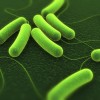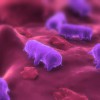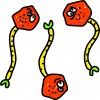 This is one in a series of fact sheets discussing common foodborne pathogens of interest to food handlers, processors, and retailers. This 5-page fact sheet was written by Keith R. Schneider, Renée Goodrich-Schneider, Michael A. Hubbard, and Susanna Richardson, and published by the UF Department of Food Science and Human Nutrition, January 2014.
This is one in a series of fact sheets discussing common foodborne pathogens of interest to food handlers, processors, and retailers. This 5-page fact sheet was written by Keith R. Schneider, Renée Goodrich-Schneider, Michael A. Hubbard, and Susanna Richardson, and published by the UF Department of Food Science and Human Nutrition, January 2014.
http://edis.ifas.ufl.edu/fs101
Tag: Michael A. Hubbard
Preventing Foodborne Illness: E. coli O157:H7
 Escherichia coli is a bacterium found in the digestive system of healthy humans and animals and transmitted through fecal contamination. There are hundreds of known E. coli strains, with E. coli O157:H7 being the most recognized. This enterohemorrhagic E. coli (or EHEC) strain is responsible for an estimated 63,153 cases of infection and 20 deaths in the United States annually, and causes approximately $255 million in losses each year. E. coli are found everywhere in the environment but mostly occupy animal surfaces and digestive systems, making it important to thoroughly wash anything that comes into contact with these surfaces. This 5-page fact sheet was written by Keith R. Schneider, Renée Goodrich Schneider, Michael A. Hubbard, and Alexandra Chang, and published by the UF Department of Food Science and Human Nutrition, October 2013.
Escherichia coli is a bacterium found in the digestive system of healthy humans and animals and transmitted through fecal contamination. There are hundreds of known E. coli strains, with E. coli O157:H7 being the most recognized. This enterohemorrhagic E. coli (or EHEC) strain is responsible for an estimated 63,153 cases of infection and 20 deaths in the United States annually, and causes approximately $255 million in losses each year. E. coli are found everywhere in the environment but mostly occupy animal surfaces and digestive systems, making it important to thoroughly wash anything that comes into contact with these surfaces. This 5-page fact sheet was written by Keith R. Schneider, Renée Goodrich Schneider, Michael A. Hubbard, and Alexandra Chang, and published by the UF Department of Food Science and Human Nutrition, October 2013.
http://edis.ifas.ufl.edu/fs097
Preventing Foodborne Illness: Salmonellosis (FSHN0214/FS096)
 In 2007, there were over 1 million cases and some 400 deaths associated with Salmonella-contaminated food. In 2004, it was estimated that the total economic burden caused by Salmonella infection in the United States was $1.6–$5.3 billion. Food handlers, processors, and retailers can minimize the risk of salmonellosis by using good food handling practices. This 6-page fact sheet was written by Keith R. Schneider, Renée Goodrich Schneider, Michael A. Hubbard, and Susanna Richardson, and published by the UF Department of Food Science and Human Nutrition, March 2013.
In 2007, there were over 1 million cases and some 400 deaths associated with Salmonella-contaminated food. In 2004, it was estimated that the total economic burden caused by Salmonella infection in the United States was $1.6–$5.3 billion. Food handlers, processors, and retailers can minimize the risk of salmonellosis by using good food handling practices. This 6-page fact sheet was written by Keith R. Schneider, Renée Goodrich Schneider, Michael A. Hubbard, and Susanna Richardson, and published by the UF Department of Food Science and Human Nutrition, March 2013.
http://edis.ifas.ufl.edu/fs096
Preventing Foodborne Illness: Listeriosis (FSHN036/FS102)
 Listeriosis is one of several foodborne diseases that are often reported in the scientific and popular press. In the United States, it affects about 1,600 people every year, with about 270 of those cases resulting in death. It expresses itself in the affected person by means of septicemia, meningitis, and/or encephalitis. Pregnant women who have intrauterine or cervical infections caused by L. monocytogenes in their second or third trimesters may spontaneously abort the fetus or produce a stillbirth. Influenza-type symptoms, which may include continuous fever, usually precede the aforementioned disorders. This 4-page fact sheet was written by Keith R. Schneider, Renée Goodrich-Schneider, Michael A. Hubbard, and Susanna Richardson, and published by the UF Department of Food Science and Human Nutrition, March 2013.
Listeriosis is one of several foodborne diseases that are often reported in the scientific and popular press. In the United States, it affects about 1,600 people every year, with about 270 of those cases resulting in death. It expresses itself in the affected person by means of septicemia, meningitis, and/or encephalitis. Pregnant women who have intrauterine or cervical infections caused by L. monocytogenes in their second or third trimesters may spontaneously abort the fetus or produce a stillbirth. Influenza-type symptoms, which may include continuous fever, usually precede the aforementioned disorders. This 4-page fact sheet was written by Keith R. Schneider, Renée Goodrich-Schneider, Michael A. Hubbard, and Susanna Richardson, and published by the UF Department of Food Science and Human Nutrition, March 2013.
http://edis.ifas.ufl.edu/fs102
FSHN03-5/FS101 Preventing Foodborne Illness Associated with Clostridium perfringens
Revised! FSHN03-5, a 3-page fact sheet by Keith R. Schneider, Renée Goodrich-Schneider, Michael A. Hubbard, and Dirk M. Sampath, provides food handlers, processors, and retailers information about foodborne illnesses caused by this Gram-postive bacterial pathogen that thrives in improperly stored meat and meat-products. Includes references. Published by the UF Department of Food Science and Human Nutrition, April 2010.
http://edis.ifas.ufl.edu/fs101
FSHN0214/FS096 Preventing Foodborne Illness: Salmonellosis
Revised! FSHN0214, a 4-page fact sheet by Keith R. Schneider, Renée Goodrich Schneider, Michael A. Hubbard, and Sarah Z. Waithe, provides the processing and retail sector with information about preventing this disease caused by bacteria that is widespread in the environment and associated with all animal species — what it is, symptoms, who is at risk, foods associated with Salmonella, as well as good practices for receiving, handling, processing, and storage. Includes references. Published by the UF Department of Food Science and Human Nutrition, September 2009.
http://edis.ifas.ufl.edu/fs096
FSHN031/FS097 Preventing Foodborne Illness: E. coli O157:H7
Revised! FSHN-03-1, a 5-page fact sheet by Keith R. Schneider, Renée Goodrich Schneider, Michael A. Hubbard, and Alexandra Chang, discusses the common foodborne pathogen E. coli O157:H7, especially as it concerns food handlers, processors and retailers. Includes references. Published by the UF Department of Food Science and Human Nutrition, November 2009.
http://edis.ifas.ufl.edu/FS097
FSHN09-02/FS147 Preventing Foodborne and Non-foodborne Illness: Vibrio vulnificus
FSHN-09-02, a 3-page fact sheet by Anita C. Wright, Renée Goodrich Schneider, Michael A. Hubbard, and Keith R. Schneider, answers questions about this illness associated with eating raw oysters, and describes how to receive and store seafood and shelfish, and how to prevent infection in high-risk individuals. Includes references. Published by the UF Department of Food Science and Human Nutrition, July 2009.
http://edis.ifas.ufl.edu/FS147
FSHN036/FS102 Preventing Foodborne Illness: Listeriosis
Revised! FHSN-03-6, a 4-page fact sheet by Keith R. Schneider, Renée Goodrich-Schneider, Michael A.
Hubbard, and Dirk Sampath, is one in a series of facts sheets discussing common foodborne pathogens of interest to food handlers, processors, and retailers. It answers questions about the causes of Listeria-associated foodborne illness, characteristics of the bacterium, how it is spread, foods associated with it, symptoms, high-risk populations, and sanitation methods for plants and food establishments. Includes references. Published by the UF Department of Food Science and Human Nutrition, August 2009.
http://edis.ifas.ufl.edu/FS102